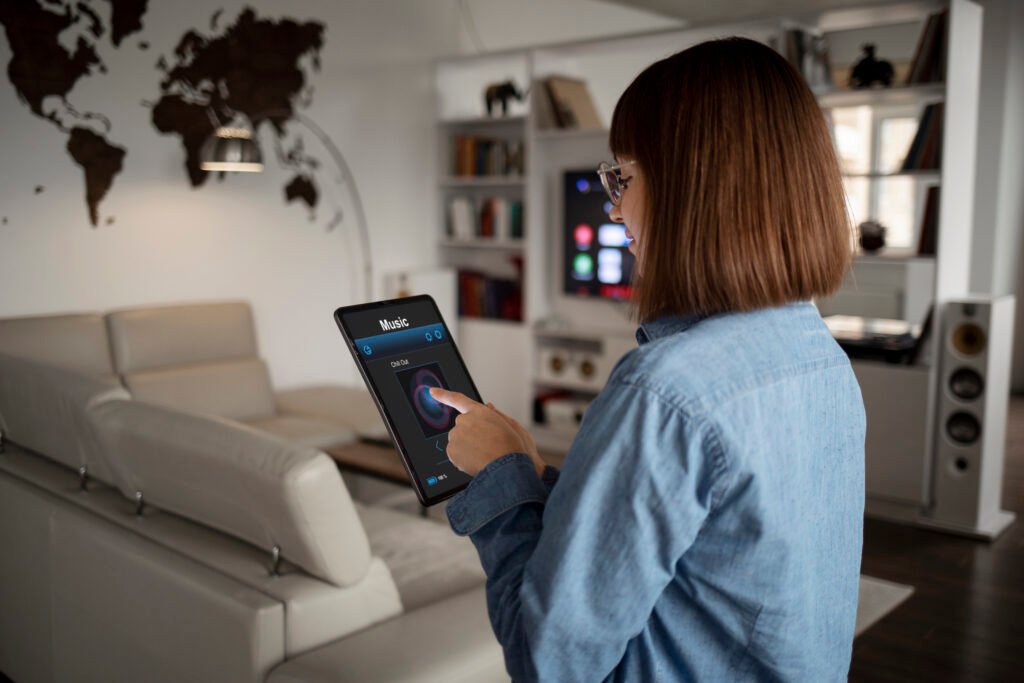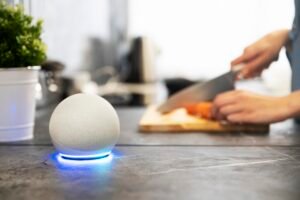Welcome to the new era of smart living spaces, fueled by the wonders of technology, where homes are more than simply basic structures; they are a connected system of gadgets made to improve people’s quality of life. Now more than ever, homes can be made smarter and safer because of the development of FPGA technology.
We’ll look at how FPGA technology is being applied to make homes smarter and safer in this blog. We’ll start by comprehending the idea of home automation and what the FPGA has to offer. Then, we’ll go into further detail on how FPGA may be used to design better living spaces, automating everything from temperature control and lighting to developing personal assistants.
We’ll finish up by talking about how FPGA can make homes safer by detecting water leaks, preventing fires and smoke, monitoring gas and carbon monoxide levels, and monitoring gas and carbon dioxide levels.
So, keep reading to find out how FPGA may alter your way of life, whether you want to automate your house, boost safety, or simply wow your friends and family!
Understanding Home Automation:
Home automation refers to the use of technology to control and automate various functions of a home. It involves the integration of various devices and systems to create a seamless and efficient environment. One of the key components of home automation is FPGAs.
1. What is Home Automation?
The automation of household processes and operations through the use of electronic devices, sensors, and communication technologies is known as “home automation.” Lighting, heating, ventilation, air conditioning (HVAC), security, entertainment, and even kitchen appliances can serve these purposes. The main objectives are to make jobs simpler, increase energy efficiency, increase security, and give residents more convenience.
2. Components of Home Automation:
Sensors: Sensors are the eyes and ears of a smart home. They detect changes in the environment and send signals to the automation system. Common types of sensors include motion sensors, temperature sensors, humidity sensors, and light sensors.
Actuators: Actuators are responsible for executing commands triggered by the automation system. They can turn lights on or off, adjust thermostat settings, or lock and unlock doors.
Controllers: Controllers act as the brains of the home automation system. They receive input from sensors, process information, and send commands to actuators. Controllers can be dedicated home automation hubs or software-based solutions on smartphones or computers.
Connectivity: Communication protocols like Wi-Fi, Bluetooth, Zigbee, and Z-Wave enable devices and systems to connect and communicate with each other and with the central controller.
User Interface: A user-friendly interface, such as a mobile app or voice command system, allows homeowners to interact with and control their smart devices and systems easily.
3. Benefits of Home Automation:
Convenience: Home automation simplifies everyday tasks by automating them or enabling remote control. For example, you can adjust your thermostat while at work or turn off lights you left on from your smartphone.
Energy Efficiency: Automated systems can optimize energy usage by adjusting heating, cooling, and lighting based on occupancy and user preferences, leading to potential cost savings.
Security: Home automation enhances security through features like smart locks, surveillance cameras, and motion-activated lighting, allowing homeowners to monitor and secure their property remotely.
Comfort: With automation, you can create customized settings for lighting, temperature, and entertainment, enhancing your overall comfort and ambiance.
Accessibility: Home automation can improve the quality of life for individuals with disabilities by providing accessible control of various home functions.
4. Common Home Automation Applications:
Smart Lighting: Control the brightness and color of lights, set schedules, and create ambiance.
Thermostats: Automatically adjust heating and cooling to save energy and maintain comfort.
Security Systems: Monitor your home with cameras, alarms, and doorbell cameras.
Smart Locks: Lock and unlock doors remotely and provide access to guests.
Entertainment Systems: Control audio and video devices with a single remote or app.
Voice Assistants: Use voice commands to control various devices and access information.
What is FPGA in Home Automation?
A specialized form of integrated circuit known as an FPGA can be configured to carry out particular functions. FPGAs are utilized in home automation to manage and control a variety of systems and devices. Compared to other types of integrated circuits like microcontrollers or digital signal processors, FPGAs provide several advantages. FPGAs are excellent for usage in home automation systems because of their extreme flexibility and simplicity of reprogramming.
Benefits of using FPGA in Home Automation:
One of the key benefits of using FPGAs in home automation is their flexibility. FPGAs can be reprogrammed easily, making it easy to modify and upgrade home automation systems. FPGAs are also highly efficient and can perform complex functions quickly and accurately. Another advantage of using FPGAs is their low power consumption, making them ideal for use in energy-efficient home automation systems.
Flexibility and Customization: In a home automation system, FPGA devices can be configured and reprogrammed to carry out particular activities or functions. Homeowners can tailor their automation installations to suit their particular needs and tastes thanks to this versatility. FPGA-based solutions are easily adaptable to controlling lighting, security, or entertainment systems.
Low Latency: Low latency is achieved via the hardware-level operation of FPGA devices. This is significant for home automation systems since real-time responses are required in some applications, including security ones, where delays might have serious consequences.
Parallel Processing: FPGAs are naturally parallel devices that can carry out numerous jobs at once. Through effective simultaneous control of several devices and sensors, in-home automation enhances system performance.
Energy Efficiency: Since many components in home automation systems run continually, it is vital to optimize FPGA designs for low power consumption. Reduced power usage increases the lifespan of linked devices and lowers energy expenditures.
High Performance: Complex computations and signal processing tasks can be efficiently handled by FPGAs. They are thus appropriate for uses such as real-time data analysis in home automation systems, voice recognition in smart speakers, and picture identification in security cameras.
Reliability: High levels of robustness and dependability are attributes of FPGAs. In comparison to software-based solutions, they are less prone to software breakdowns and vulnerabilities, assuring the continuous operation of home automation systems.
Security: FPGA-based systems can offer enhanced security features, including hardware-based encryption and tamper-resistant designs. This is crucial for protecting sensitive data and ensuring the integrity of home automation networks.
Scalability: FPGAs can be easily scaled up or down to accommodate the growing needs of a home automation system. Whether you’re adding more smart devices or expanding the scope of automation, FPGAs can adapt without the need for extensive hardware changes.
Longevity: FPGAs typically have a longer lifespan compared to off-the-shelf consumer electronics. This ensures that your home automation system remains functional and up-to-date for years without frequent replacements.
Real-time Signal Processing: FPGA-based solutions excel in real-time signal processing tasks, making them suitable for applications like audio and video processing in home theaters or smart homes with complex automation requirements.
Reduced Hardware Footprint: FPGAs can consolidate multiple functions into a single chip, reducing the need for multiple hardware components. This can lead to a more compact and efficient home automation system.
Support for Legacy Systems: FPGAs can bridge the gap between older, non-smart devices and modern automation systems by integrating them into the network, extending the lifespan of legacy appliances and equipment
Challenges of implementing FPGA in Home Automation:
Implementing FPGA (Field-Programmable Gate Array) technology in home automation brings numerous benefits, as discussed earlier. However, it also presents certain challenges that need to be considered. Here are some of the challenges associated with implementing FPGA in home automation:
Complexity of Programming: Hardware description languages (HDLs) like VHDL or Verilog demand particular knowledge and proficiency for FPGA programming. The writing and debugging of FPGA code may be difficult for homeowners and even some developers. The general acceptance of this intricacy may be hampered by non-experts.
Cost: Compared to commonly available microcontrollers or microprocessors, FPGAs are often more expensive. When attempting to adopt FPGA-based home automation systems, individuals or smaller businesses may find the cost of FPGA development boards, tools, and licenses to be a hurdle.
Development Time: Designing and implementing FPGA-based solutions can be time-consuming. The development cycle may be longer compared to using pre-made microcontroller-based platforms. This can delay the deployment of home automation systems.
Limited Commercial Off-the-Shelf (COTS) Solutions: FPGA solutions frequently require special creation for particular jobs, in contrast to microcontrollers, which have access to a wide selection of pre-built hardware and software components. For FPGA-based home automation, it can be difficult to find COTS solutions.
Resource Constraints: FPGAs have finite hardware resources, including logic gates, memory, and input/output pins. Ensuring that the FPGA has enough resources to accommodate all desired functions and features can be a complex optimization task.
Energy Efficiency Trade-offs: While FPGAs can be power-efficient when optimized, they can also consume more power than low-power microcontroller-based solutions when not programmed efficiently. Balancing performance with energy efficiency can be tricky.
Updates and Maintenance: Updating and maintaining FPGA-based home automation systems can be more involved than updating software-based systems. It may require physically reprogramming the FPGA, which can be inconvenient.
Integration Complexity: Integrating FPGA-based components with existing home automation systems or third-party devices can be challenging. Compatibility and communication protocols must be carefully considered and implemented.
Testing and Debugging: Debugging FPGA designs can be complex and time-consuming. Finding and fixing hardware-level bugs can be more challenging than debugging software.
Lack of Standardization: Unlike some microcontroller-based platforms that adhere to industry standards and protocols, FPGA implementations in home automation may lack standardization, making interoperability between devices from different manufacturers more difficult.
Skill Gap: There may be a shortage of professionals with FPGA programming expertise in the home automation industry, which can make it difficult to find qualified developers for FPGA-based projects.
Security Concerns: While FPGAs can offer hardware-level security features, they can also be susceptible to physical attacks if not properly secured. Ensuring the security of FPGA-based home automation systems is crucial
Creating Smarter Living Spaces:
FPGAs are being used in home automation to create smarter living spaces. Smart homes are equipped with devices and systems that can be controlled remotely, providing greater convenience and control to homeowners.
Here are some ways in which FPGAs are being used to create smarter living spaces:
Automating Lighting and Temperature Control:
FPGAs can be used to create specialized lighting and temperature control systems. These systems can be configured to adjust the temperature and lighting based on the time of day, the number of people present, and other factors. For instance, FPGAs can be used to create lighting systems that adjust the color and intensity of the lights in response to home intelligent security systems.
These systems can be programmed to identify potential dangers and respond appropriately. They may contain a range of security tools, such as cameras and motion detectors. For instance, a security system based on an FPGA may analyze a camera feed and alert homeowners to an intrusion. FPGAs can be used to alter the user preferences or the time of day.
Intelligent Security Systems for Homes:
FPGAs can be used to create intelligent security systems for homes. These systems can integrate various security devices, such as cameras and motion sensors, and can be programmed to identify and respond to potential threats. For example, an FPGA-based security system can analyze a camera feed and alert homeowners if it detects an intruder.
Remote Access to Smart Home Appliances:
FPGAs enable the creation of remote-controlled smart home appliances. These appliances can be programmed to do specific tasks based on user preferences. For instance, the wash cycle and water temperature of an FPGA-based washing machine may be programmed to change depending on the fabric being washed. Users can control these appliances through their mobile devices, providing more convenience and control.
Building Personal Assistants using FPGA in Home Automation:
FPGAs can be used to create intelligent personal assistants that can play music, control devices, answer questions, and carry out other tasks. These assistants can be designed to follow voice commands and can be customized to the user’s preferences. For example, a personal assistant built on an FPGA may be taught to read the news, place grocery orders, and provide weather predictions.
Creating Safer Living Spaces:
FPGAs are also being used in home automation to create safer living spaces. Here are some ways in which FPGAs are being used to create safer living spaces:
Fire and Smoke Detection Systems:
Highly precise fire and smoke detection systems can be made using FPGAs. These systems can be set to recognize heat and smoke using a variety of sensors, and they can notify homeowners if a fire occurs. Fire suppression systems that extinguish fires automatically can also be made using FPGAs.
Gas and Carbon Monoxide Monitoring Systems:
Highly dependable systems for monitoring gases and carbon monoxide can be built using FPGAs. These systems can be set up to use specific sensors and can notify homeowners if there is a leak of gas or CO.
Water Leak Detection and Flood Prevention Systems:
Systems for water leak detection and flood prevention can be built using FPGAs. To stop floods, these systems can be designed to find leaks and turn off the water supply. Additionally, sump pumps that can remove water from a flooded basement can be made using FPGAs.
Surveillance and Access Control Systems:
FPGAs can be used to create extremely effective surveillance and access control systems. These systems include various cameras and sensors to keep an eye on the house and can be trained to recognize and respond to potential threats. FPGAs can also be used to create keyless entry systems that enable access to the residence without a set of keys.
Future Trends and Innovations
As the world of home automation continues to evolve, FPGA (Field-Programmable Gate Array) technology plays a pivotal role in shaping the future of smarter and more efficient living spaces. Here are some of the exciting trends and innovations we can anticipate:
AI and Machine Learning Integration: The incorporation of artificial intelligence (AI) and machine learning (ML) into FPGA-based home automation systems is one of the most promising trends. FPGAs are excellent for speeding up AI inferencing operations, allowing devices to gradually learn and adjust to homeowners’ preferences. More knowledgeable and foresighted automation systems that can predict human needs will result from this.
Edge Computing: FPGAs are ideal for edge computing, where data is processed locally on devices rather than in the cloud. This trend will enhance privacy and reduce latency, enabling faster response times for critical home automation tasks such as security and voice recognition.
Energy Efficiency Enhancements: With a growing focus on sustainability and energy conservation, FPGA-based home automation systems will continue to optimize energy usage. This includes advanced algorithms for scheduling and controlling devices to minimize energy consumption and reduce carbon footprints.
IoT Integration: The Internet of Things (IoT) is becoming more prevalent in homes, with an increasing number of connected devices. FPGAs will facilitate the seamless integration of these devices, ensuring compatibility, security, and efficient communication between smart appliances, sensors, and central control systems.
Natural Language Processing (NLP): FPGA technology will play a significant role in advancing natural language processing capabilities in home automation systems. This will enable more conversational and intuitive interactions with smart devices, making them easier for users to control and manage.
Customized Hardware Modules: FPGA-based systems will increasingly feature customized hardware modules designed for specific home automation tasks. These modules will enhance performance, reduce power consumption, and streamline the integration of new features and functionalities.
Enhanced Security Features: As cyber threats become more sophisticated, FPGA-based home automation systems will incorporate advanced security measures. Hardware-level encryption, secure boot mechanisms, and tamper detection will become standard features to protect sensitive user data and privacy.
3D Sensing and Imaging: FPGAs are well-suited for 3D sensing and imaging applications. This technology will enable more advanced features in home automation, such as gesture recognition, augmented reality experiences, and more immersive home entertainment.
Cloud Integration: While edge computing is on the rise, cloud integration will continue to be important for data storage, remote access, and software updates. FPGA-based systems will provide efficient and secure cloud connectivity for home automation solutions.
User-Centric Design: Future FPGA-based home automation solutions will prioritize user experience and ease of use. User-centric design principles will result in intuitive interfaces, simplified installation processes, and seamless device management.
Interoperability Standards: Efforts to establish interoperability standards for home automation systems will gain momentum. This will make it easier for homeowners to mix and match devices from different manufacturers while ensuring compatibility and security.
Augmented Reality (AR) and Virtual Reality (VR): FPGAs will enable more immersive AR and VR experiences within the home, creating virtual environments for entertainment, remote collaboration, and enhanced home automation control.
Conclusion:
Through home automation, FPGAs enable the development of smarter and safer living environments. FPGAs are being utilized to build incredibly effective and individualized home automation systems, ranging from specialized lighting and temperature control systems to sophisticated security systems and personal assistants. FPGAs are a valuable complement to any home automation system, even though there are certain difficulties involved in their implementation.



![What is FPGA Introduction to FPGA Basics [2023] computer-chip-dark-background-with-word-intel-it](https://fpgainsights.com/wp-content/uploads/2023/06/computer-chip-dark-background-with-word-intel-it-300x171.jpg)








